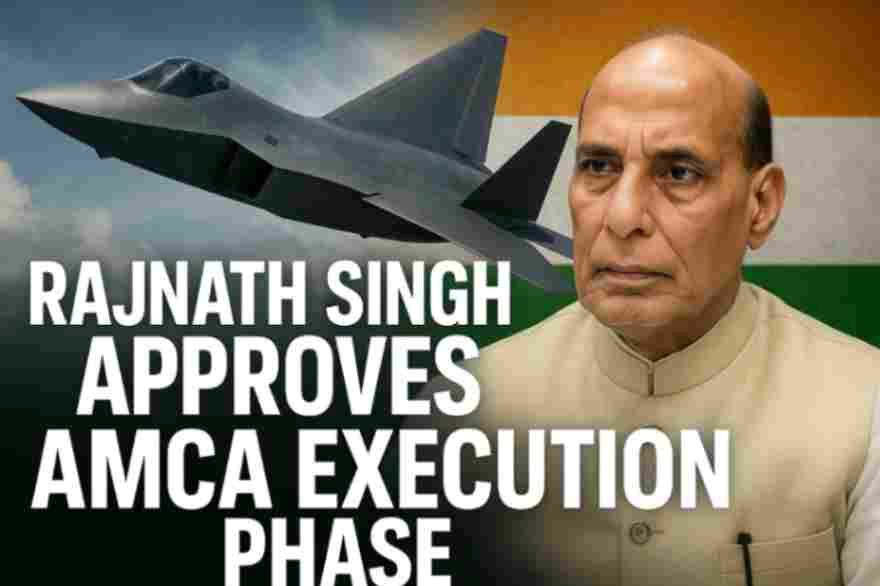
India’s defense capabilities are taking a bold leap into the future. With the official greenlight from Defence Minister Rajnath Singh, the much-anticipated 5th-gen stealth fighter jet program — the AMCA project — is now entering its execution phase. This move places India firmly on the path to joining an elite global club of nations developing indigenous fifth-generation stealth aircraft.
What Is the AMCA Project?
The Advanced Medium Combat Aircraft (AMCA) is India’s answer to modern aerial warfare. Designed as a twin-engine, multi-role stealth fighter jet, the AMCA will be equipped with advanced avionics, supercruise capability, and next-gen stealth technology.
Key specs of the AMCA:
- Single-seat, twin-engine configuration
- Stealth-focused design
- Internal weapons bay
- Supercruise ability (sustained supersonic flight without afterburners)
- Sensor fusion and advanced electronic warfare systems
The project is led by the Aeronautical Development Agency (ADA) in collaboration with the Defence Research and Development Organisation (DRDO) and private defense partners.
Source: The Hindu
Rajnath Singh’s Statement on AMCA Approval
In a landmark announcement that signals a turning point in India’s defense preparedness, Defence Minister Rajnath Singh said, “The approval of the AMCA project represents a new dawn for India’s aerospace capabilities. With indigenous design and development, India is not only progressing towards self-reliance but also positioning itself as a formidable force in modern aerial combat. The AMCA will not just strengthen our national security but also showcase India’s technological prowess to the world.”
He emphasized the importance of industry collaboration, stating, “The partnership between DRDO, ADA, and Indian private industry underlines our commitment to building a strong domestic defense ecosystem. This project will empower our youth, boost our economy, and solidify India’s place among global aerospace leaders.”
In a major push for #AatmanirbharBharat in defence, Raksha Mantri Shri @rajnathsingh has approved the Execution Model for the Advanced Medium Combat Aircraft (#AMCA) programme. The Aeronautical Development Agency (ADA) will lead the project in partnership with Indian industry.… pic.twitter.com/CpBNGzkKcA
— Ministry of Defence, Government of India (@SpokespersonMoD) May 27, 2025
Source: Ministry of Defence, Government of India
Rajnath Singh Approves AMCA Execution Phase
The approval from Defence Minister Rajnath Singh marks a strategic milestone. The execution model includes participation from both public and private sectors to enhance competitiveness and drive innovation. The Indian Air Force is expected to induct the first AMCA units by the early 2030s, with full-scale production targeted around 2035.
Read Also: Rajnath Singh Declares: Indian Armed Forces Have Brought Pakistan’s Military to Its Knees
Why India Needs a 5th-Gen Stealth Fighter Jet
India’s geopolitical neighborhood — with China’s J-20 and Pakistan’s growing air capabilities — necessitates an indigenous 5th-gen fighter. The AMCA will:
- Serve as a deterrent to regional threats
- Enhance India’s air superiority
- Replace ageing fleets like MiG-29 and Mirage 2000
- Reduce reliance on foreign technology
AMCA vs Global Rivals
| Feature | AMCA (India) | J-20 (China) | F-35 (USA) |
| Engines | Twin | Twin | Single |
| Supercruise | Yes | Yes | Yes |
| Stealth | Advanced | Yes | Yes |
| Avionics | State-of-the-art | Advanced | Cutting-edge |
| Status | Execution phase | In service | In service |
Key Features That Set AMCA Apart
- Indigenous Design: 100% designed in India under ‘Make in India’
- Stealth Profile: Radar-absorbing materials and internal weapon storage
- AI-Enabled Avionics: Future-ready cockpit and avionics
- Advanced Radar: AESA radar, electronic countermeasures, sensor fusion
Timeline: AMCA Project Milestones
- 2009: Initial concept studies
- 2019: First wind tunnel tests
- 2023: Design freeze and configuration finalization
- 2024: Cabinet approval and budget allocation
- 2025: Execution phase begins
- 2030: Prototype test flights expected
- 2035: Planned full-scale production
Atmanirbhar Bharat in Action
The AMCA initiative is a prime example of the Atmanirbhar Bharat vision — boosting self-reliance in defense. Indigenous components will power most of the AMCA’s systems, including:
- Flight control software
- Onboard mission systems
- Weapon integration suites
- Radar and EW systems
Economic and Industrial Impact
The AMCA project is more than just defense hardware — it’s an economic opportunity. It’s set to:
- Create over 100,000 direct and indirect jobs
- Boost India’s aerospace manufacturing ecosystem
- Promote private-public R&D collaboration
- Position India as a global aerospace exporter
Challenges Ahead for the AMCA Project
Despite the optimism, the road ahead isn’t without hurdles:
- Engine Development: India currently lacks a domestic 5th-gen engine.
- Funding Gaps: Advanced military projects demand large, consistent funding.
- Technology Transfer: Limited access to certain global stealth technologies.
However, collaboration with global allies and domestic innovation are expected to close these gaps over time.
How Global Experts View the AMCA
Defense analysts around the world have praised India’s ambition:
- “AMCA will establish India’s technological credibility in the aerospace domain.”
- “The modular approach of the project allows flexible upgrades.”
- “India’s AMCA project could challenge China’s dominance in the region.”
India’s Future Air Power Strategy
The AMCA is part of a broader modernization plan that includes:
- Upgrading Su-30 MKI fighters
- Procurement of Tejas Mark 2
- Enhancing drone warfare capabilities
- Integrated battlefield command systems
The synergy between these projects will shape the Indian Air Force’s dominance through 2040 and beyond.
What’s Next?
With the execution phase kicking off in 2025, the next five years will be critical:
- Finalizing prototype designs
- Beginning flight testing
- Scaling up defense-industrial infrastructure
- Securing global partnerships for technology infusion
A Defining Moment for Indian Defense
The 5th-gen stealth fighter jet — the AMCA project — is not just about catching up with global powers. It’s about setting new standards. With strong political will from leaders like Rajnath Singh, and the strategic vision of ADA and DRDO, India is well on its way to becoming a major aerospace power.
Stay tuned — the AMCA’s journey could reshape the future of air combat in Asia.





